- How to evaluate the energy efficiency of an air conditioner?
- What are the criteria for the energy efficiency of an air conditioner?
- What does SEER/SCOP mean?
- What does BTU mean?
- How to choose an air conditioner with a proper BTU / h capacity?
- How many kW in a BTU?
- How to decipher the labeling of the air conditioner?
- Which air conditioners are definitely not energy efficient?
- What are inverter air conditioners?
- Which air conditioner is better: inverter or standard?
- How to improve and reduce the cost of air conditioning? Practical recommendations.
When buying an air conditioner, it is important to understand how much we will have to pay for electricity.
The energy efficiency of an air conditioner is one of the most important indicators that are evaluated when choosing a system. It determines the amount of electricity consumed by the device to achieve a comfortable room temperature.
In other words, the energy efficiency level of the device determines how much you have to pay for comfort.
If the energy efficiency is low, the device uses a lot of electricity, and you will have to pay more for it.
If you choose a high-performance air conditioner, you can save on your electricity bill.
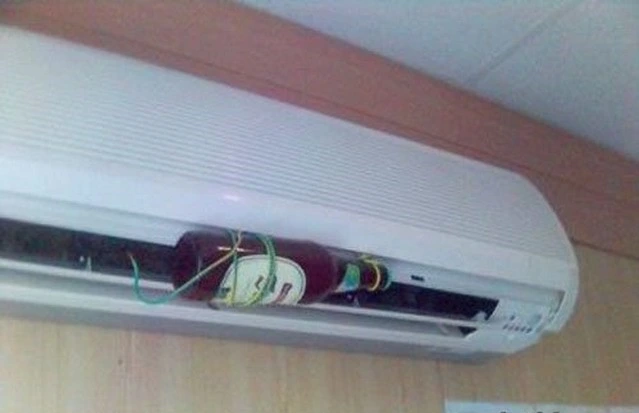
1. How to assess the energy efficiency of an air conditioner?
When assessing energy efficiency, how the air conditioner works is taken into account.
Modern devices can not only cool the air in the room but also heat it. The latter quality is especially useful in mid-seasons when heating is not yet in use.
On average, the air conditioner works in this mode for about one to two months a year (depending on the climatic characteristics of the region).
In cooling mode, the air conditioner works mainly during the warmer months, so most of the electricity bill comes in the summer.
2. What are the criteria for the energy efficiency of an air conditioner?
To find out which air conditioner is better, you need to focus on the following criteria:
- Device type: wall, cassette, mobile phone, window, channel.
- Compressor. Pay attention to the inverter. In it, the electronic panel dynamically changes the voltage to reduce current consumption.
- Energy. The larger the room, the greater the power. Calculate the parameters according to the rule: not less than 1 kW per 10 sq. m.
- Energy efficiency class. The system is considered effective if it complies with classes A, A +, A ++ and A +++. That is, the coefficient is equal to or greater than 3.2.
- Unit size. Recommended average dimensions of the indoor unit – height from 24 cm, depth from 18 cm, width from 60 cm. The recommended average dimensions of the outdoor unit – height from 42 cm, width from 65, depth from 25 cm.
- Heating. The option is designed for autumn when the heating season has not begun but it is already cold outside the window, or for mild winters.
- Cooling. The option is provided for the summer season and rooms with windows on the sunny side.
- Dehumidification. The feature removes excess moisture from the air to save the dwelling from mold problems.
- Ventilation. Renew the stagnant air in the room.
- Air cleaning. Removes dust or animal hair.
- Oxygen saturation. These are systems that remove excess nitrogen outside or trap it in their own membranes to saturate the air with oxygen.
- Additional options. Other options include sleep mode, motion sensor, Wi-Fi control, self-diagnostics, outdoor unit defrosting, etc. They are found in almost all modern systems.
3. What does SEER/SCOP mean?
You also need to find some abbreviations in the product description. Energy efficiency indicators are presented in the form of two coefficients:
SEER (Seasonal Energy Efficiency Ratio) – to assess electricity consumption for cooling.
SCOP (Seasonal Coefficient of Performance) – to assess heating efficiency
The higher the number, the greater the energy efficiency of the air conditioner.
But there is a nuance – these coefficients determine the performance at a time when the air conditioner works at full load. And when the desired ambient temperature is reached, the devices work at partial load. In such a case, the indicators of efficiency grow 5 times and more. That is, even less energy is consumed.
| Cooling | Energy Efficiency Class | Heating |
SEER ≥ 8,50 | A+++ | SCOP ≥ 5,10 |
6,10 ≤ SEER < 8,50 | A++ | 4,60 ≤ SCOP < 5,10 |
5,60 ≤ SEER < 6,10 | A+ | 4,00 ≤ SCOP < 4,60 |
5,10 ≥ SEER < 5,60 | A | 3,40 ≤ SCOP < 4,00 |
4,60 ≤ SEER < 5,10 | B | 3,10 ≤ SCOP < 3,40 |
4,10 ≤ SEER < 4,60 | C | 2,80 ≤ SCOP < 3,10 |
3,60 ≤ SEER < 4,10 | D | 2,50 ≤ SCOP < 2,80 |

4. What does BTU mean?
The abbreviation BTU stands for British Thermal Unit – and stands for units of measurement of thermal energy in the British measurement system. BTU is defined as the amount of heat needed to heat 1 pound of water of 1 degree Fahrenheit. 1 BTU is estimated at about 1.06 kilojoules and 1 BTU is equal to 0.3 watts. BTU is not officially included in the international system, however, this unit is widely used in almost all countries of the world to denote the capacity of air conditioners.
As a rule, most models of household air conditioners work in the range of 5000-18000 BTU, so a large number of BTUs, corresponds to a higher speed to cool a room.
5. How to choose an air conditioner with a proper BTU / h capacity?
First, you need to get information about the dimensions of the room in which you plan to place the future air conditioner, the capacity of which, as mentioned above, is indicated in the specifications in BTU.
If the room is of simple shape, we measure the length and width of the room, multiply them and thus obtain the required dimensions in square meters.
If there are several rooms, it is better to measure the size of each by noting the values obtained, for example, in a smartphone.
Next, multiply the surface of the room by its height (as a rule, about 300 cm). For example, if the length of the room is 5 meters, and the width is 5 meters, its area is 25 m. 30 x 300, and we get 9000. Therefore, an air conditioner with a capacity of 10,000 BTU / hour is suitable for efficient cooling of this room. It is also possible to install a model with a larger cooling capacity, however, it is likely to be more expensive at the time of purchase and will surely cost more during operation.
Floor area of the space | Room height | ||
2.6 m | 3 m | 4 m | |
10 m2 | 5000 | 5000 | 7000 |
14 m2 | 5000 | 5000 | 9000 |
16 m2 | 7000 | 7000 | 9000 |
18 m2 | 7000 | 7000 | 9000 |
20 m2 | 9000 | 9000 | 12000 |
22 m2 | 9000 | 12000 | 12000 |
26 m2 | 12000 | 12000 | 18000 |
28 m2 | 12000 | 12000 | 18000 |
30 m2 | 12000 | 18000 | 18000 |
36 m2 | 18000 | 18000 | 18000 |
40 m2 | 18000 | 18000 | 24000 |
50 m2 | 18000 | 24000 | 28000 |
70 m2 | 24000 | 28000 | 35000 |
80 m2 | 28000 | 30000 | 40000 |
90 m2 | 30000 | 32000 | 42000 |
105 m2 | 36000 | 40000 | 52000 |
6. How many kW in a BTU?
1 BTU = 0.2931 W
Power match in BTU and kW
BTU | 5000 | 7000 | 9000 | 12000 | 18000 | 24000 |
kW | 1.5 | 2.1 | 2.5 | 3.5 | 5 | 7 |
|
|
|
|
|
|
|
BTU | 28000 | 32000 | 36000 | 40000 | 52000 |
|
kW | 8.5 | 9.5 | 10.5 | 11.5 | 15.3 |
|
7. How to decipher the labeling of the air conditioner?
The front panel of the inverter or unit also shows the model name and markings from a series of numbers and letters.
Let’s see how these values are decoded. Decoding of markings on air conditioners:
GWH or SRK is a domestic air conditioning device, GU or SRR is a type of semi-industrial equipment.
The next two digits – 07, 09, 12, 13, 14, 18, 24, 27, or 30 – are the capacity of the split system, measured in BTU/hour.
“07” is a power of 2.1 watts, “09” is 2.6 watts, “12” is 3.5 watts, “18” is 5.2 watts, and so on.
The following are alphabetical and numeric values that define the pattern and pattern of the tool.
The last set of numbers – 1/4 3/8, 1/4 1/2 or 1/4, 5/8 specifies the diameter of the copper tube, indicated in inches.
In addition to digital and alphabetical values, additional stickers and markings may be present on the air conditioner housing, which show additional functions of the device.
8. Which air conditioners are definitely not energy efficient?

Manufacturers are constantly working to ensure that air conditioners require less and less energy to operate. HVAC equipment produced before 2013 will clearly be energy inefficient.
Air conditioners with a low energy efficiency index automatically include systems of obsolete classes “E”, “F” and “G”.
These products do not comply with new regulations and cannot compete with modern innovative technologies.
9. What are inverter air conditioners?
In the modern market, the most energy-efficient are inverter models. Savings are achieved by varying the frequency of rotation of the motor. Once the temperature is reached, the engine slows down. This allows you to reduce energy consumption by 40-58% compared to conventional air conditioning systems.
10. Which air conditioner is better: inverter or standard?
Comparison between inverter and standard air conditioner:
Type of air conditioner |
Advantages |
Disadvantages |
Inverter |
|
|
Non-inverter |
|
|
Among other things, inverter models have the following characteristics:
- wide range of temperature conditions,
- reduced noise effect,
- operational cooling/heating,
- environmental friendliness of refrigerants.
In addition, the built-in surge protection ensures a long service life of the equipment.
11. How to improve and reduce the cost of air conditioning? Practical recommendations
We have long been accustomed to the comfort and coolness that air conditioners provide on hot days. However, not everyone knows how to use an air conditioner so that it works efficiently and economically.
First of all, we remind you:
- Any air conditioner needs maintenance. Even if the device works properly, at least once a year (preferably in the spring, while it is not very hot), you need to call a specialist who will check the entire system and perform proper routine maintenance. It is important to remember that the sooner the problem is identified and eliminated, the longer and better the air conditioner will work. In addition, the cost of maintaining air conditioners is always lower than overhauling or replacing them.
- Insulate the attic floor (and/or attic) and the basement so that on hot days as little warm air as possible enters the house. The hotter the air in the house, the longer the air conditioner must work, as a result, it wears out faster and consumes more electricity.
- Make sure that the air conditioners installed are the correct size and capacity to effectively cool the air in their respective rooms. A large and powerful air conditioner, once again, consumes more electricity, and, in addition, in a small room it will not work as efficiently as a smaller and less powerful device, but correctly selected.
- You can install in the house several conventional fans or a modern ventilation system based on them. Conventional fans allow you to do without expensive air conditioners on days that are not too hot or at night when the air outside the house is colder than inside.
- Try to close the windows in time with awnings, screens, or special films, so that in the warm season direct sunlight does not penetrate the premises and does not heat the interior items and walls.
- Use ceiling fans in the rooms. Moving the air in the rooms creates a feeling of coolness and in fact lowers the temperature in our “internal thermometers”, so that on some days it is possible to feel quite well without an air conditioner.
- Do not install lighting fixtures, televisions and other household electronic devices near the thermostat of the air conditioning system. The thermostat will take into account the heat generated by these devices, and the air conditioners will work longer than necessary.
- Set the chronothermostat and in the settings the automatic mode, set the temperature a few degrees more when you are away from home and at night when you sleep. In addition, this thermostat also allows you to preheat the room, for example, when you get home.
- If the outdoor unit of the air conditioner is installed in a shady place, even on very hot days, the system will consume about 10% less electricity. But in this case, remember that you can not install the outdoor unit very close to the walls of neighboring buildings or trees, which can block the flow of air.
- During prolonged and active operation of the air conditioner, its filter should be changed once a month. Experts advise buying pleated filters that trap more dirt and dust than cheaper but less efficient flat ones.
- It is better to replace incandescent lamps in the house with modern LED lamps. LED lamps generate much less heat, which is especially important during the warm season.
Please don't try this at home! 🙂
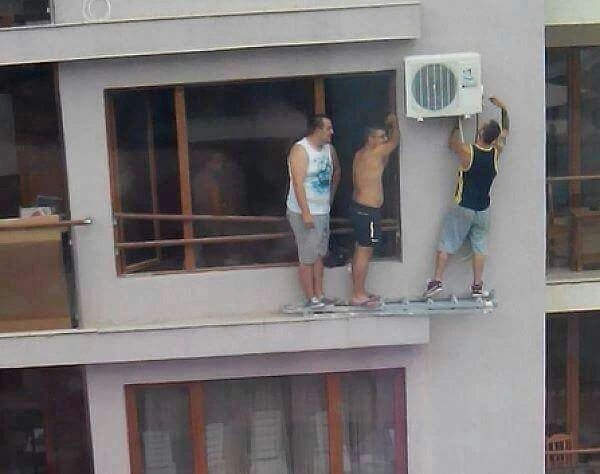

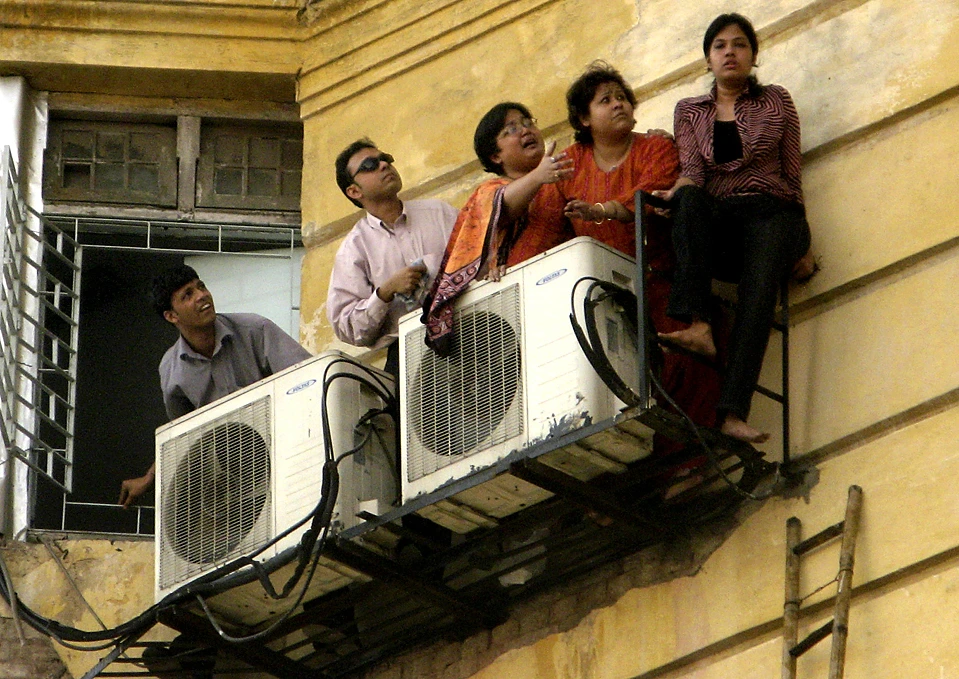

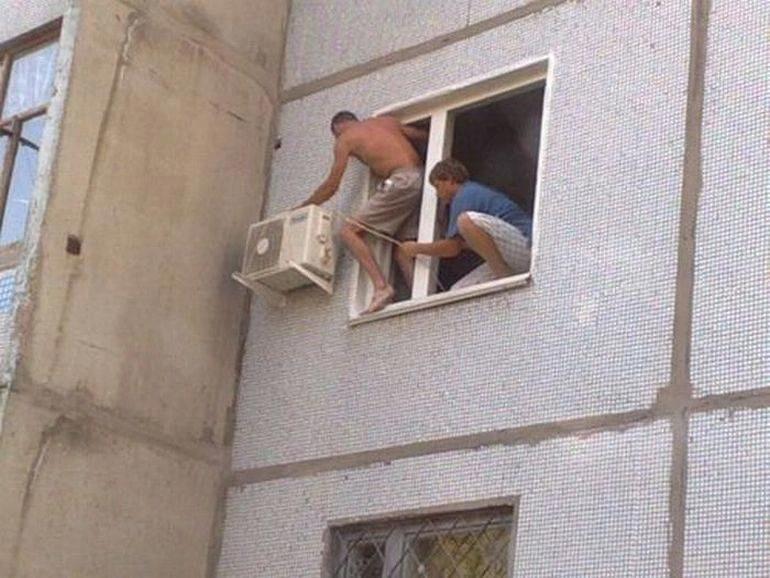
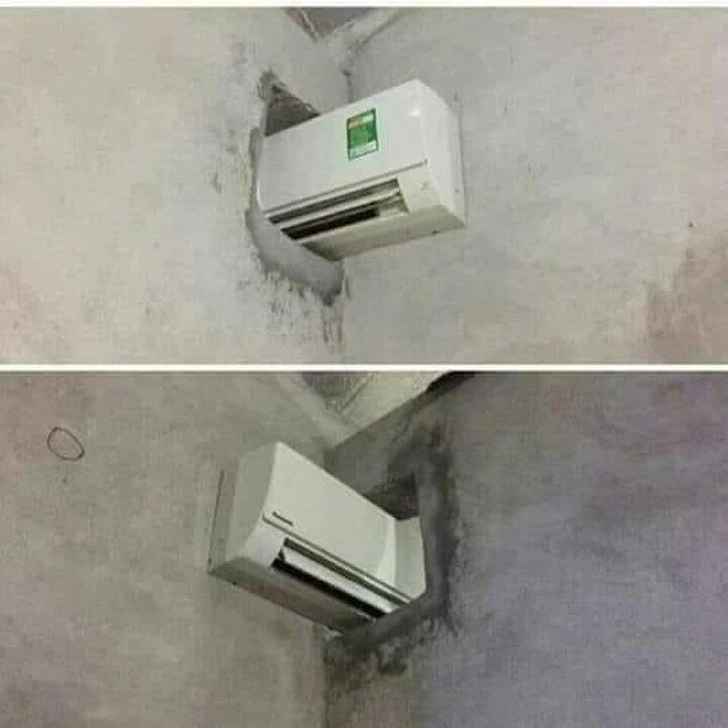








Add a comment